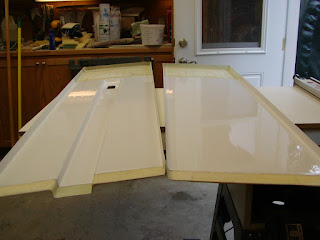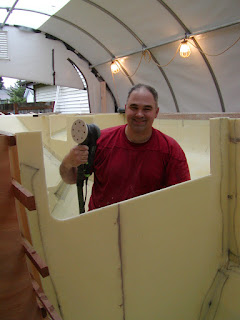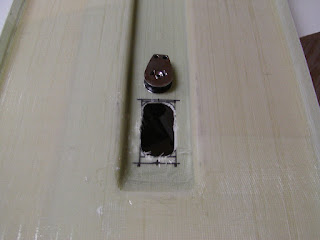As others have commented, the builder's update that Ian sent out recently was full of great information. The part I cared about the most was the daggerboard case cheekblock details. Nothing was unexpected once I saw the sheet, but now I felt confident enough to proceed with the case construction. I couldn't find a Ronstan 1709 cheekblock as suggested by Ian, but the RF40151HL model looks like it will work. Here it is sitting next to the hole in the case:
Note that Ian specifies that the cheekblock plate be anodised. I've been looking online for a Seattle metal finisher that can do this type of work...there are several, but they all look like heavy-duty industrial outfits. Perhaps I may try to do it myself (there are many DIY kits available, e.g.: http://www.caswellplating.com/).
I have decided to paint the upper interior portion of the daggerboard case with Alexseal 2-part LPU, and the lower interior portion with a copper-based anti-fouling paint (Pettit Copper Bronze). After ten coats of fairing compound...just kidding! :-) No fairing compound at all - yesterday I brushed on three coats of Alexseal primer, and today I sanded it all down smooth (nothing extravagant, just to 320 grit and I didn't try to fill any holes) then setup my sprayer and put on two coats of paint. It's not perfect but should work okay:

And:


I also spent a few hours today in the hull sanding down all of the tapes:

I briefly tried to tape the aft compartment under the aft cabin bunktop, but it turned out to be a nightmare of a job. I couldn't even get fillets formed, working with long sticks, and didn't even get to the point of trying to force glass down into the cracks. Not yet sure what I am going to do about this -- might give up and let it be.
With sanding done, and the settee flange and the sterndeck done, I'm now pretty much ready to get this hull half unmolded. My plan for this is to set up sawhorses in the back yard, lay lumber across them, level them as best I can, and lay the hull on them. I hope this works - my yard isn't all that flat. But I don't really have an alternative plan.
I had forgotten to re-tarp my floats (out of sight, out of mind) and didn't notice until today. They've been getting a good dose of Northwest weather:

Finally, Ian sent me an email to let me know that my beam mounts were sent out air-mail on Friday.










































